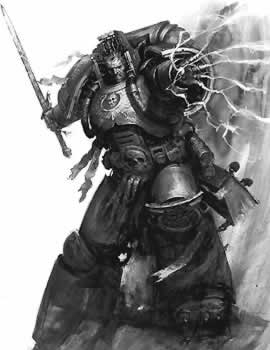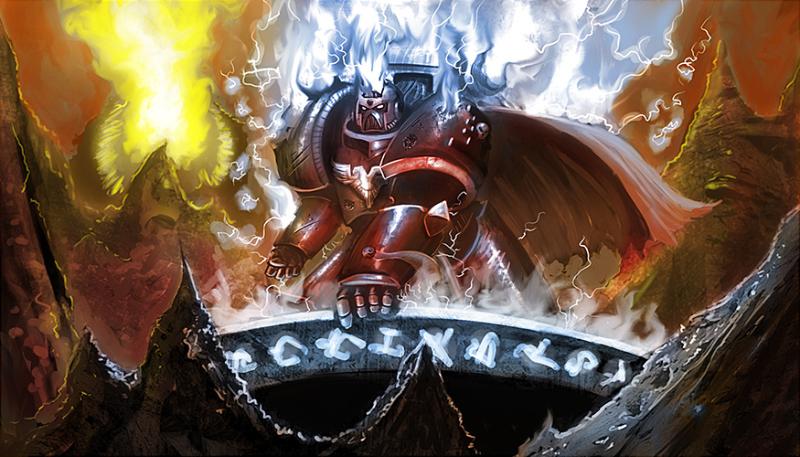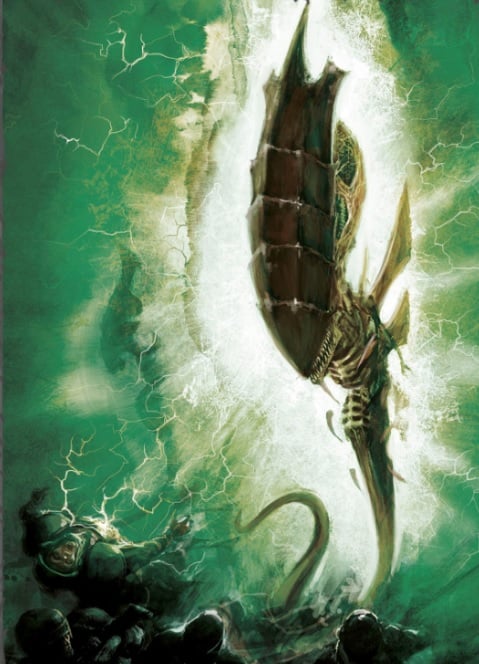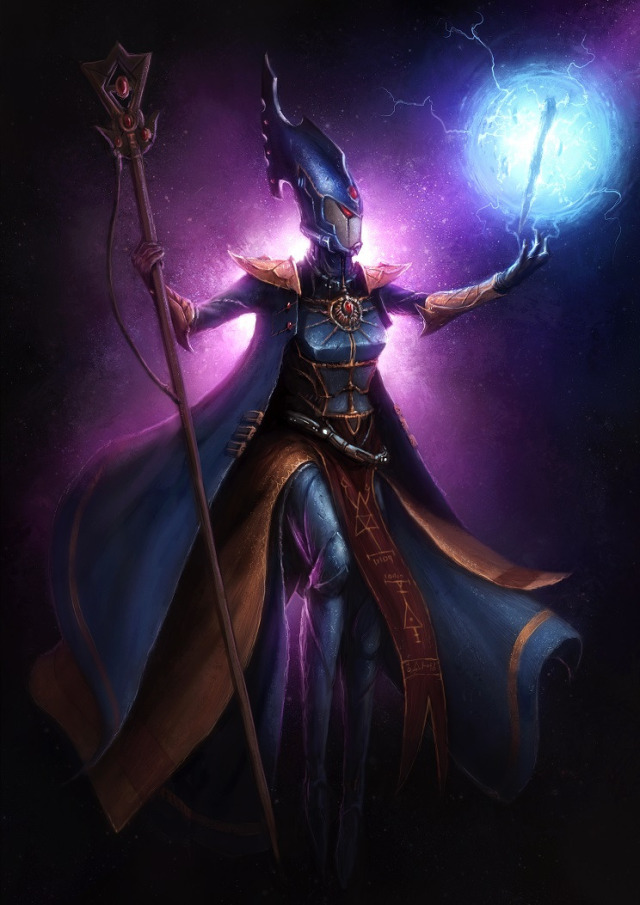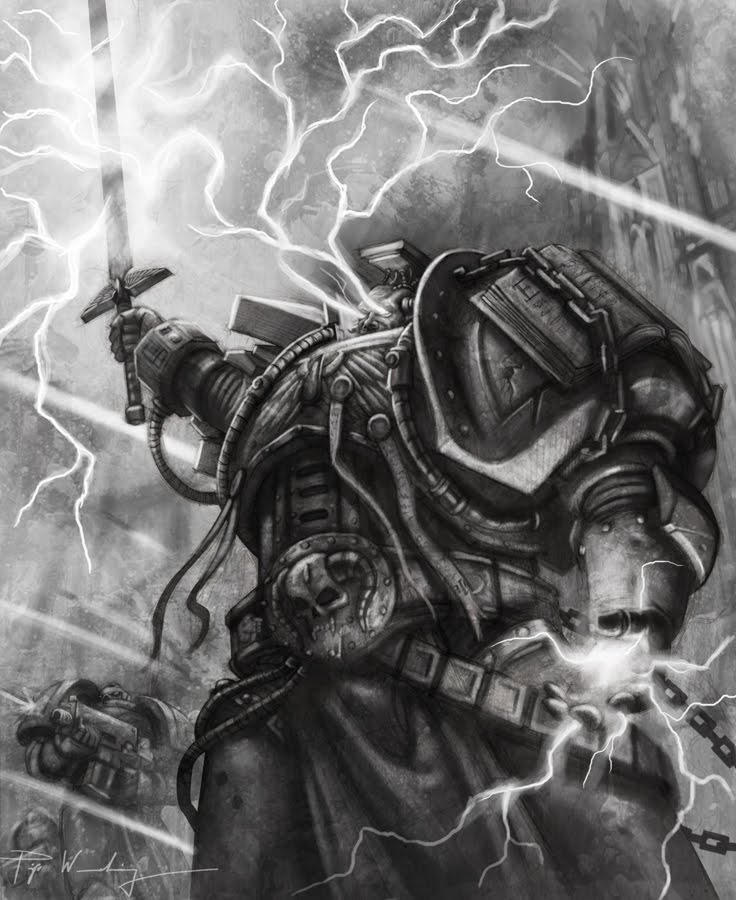Psykers in 7th Edition – An Introduction

Hey there ladies and gentlemen, my name is Learn2Eel from Imperator Guides and today I wanted to discuss extended psyker rules!
The addition of a “Psychic Phase” joins Challenges and Overwatch/Stand and Shoot as the latest rules making the jump from Warhammer Fantasy to Games Workshops’ science fiction series in the past few years. I hope you enjoy this article!
Psykers
The Psychic Phase
As described earlier, the Psychic Phase is yet another attempt at bringing Warhammer 40,000 in line with Warhammer Fantasy as it clearly apes the Magic Phase. Wizards in Warhammer Fantasy tend to be at far greater risk to both themselves and friendly warriors, but the powers they can unleash are on an entirely different level to those found in the grim darkness of the 41st millennium. Making a dedicated Psychic Phase is a clear indication that 7th Edition psykers will be far more capable of changing the game than before, especially as the way denying those powers works is potentially less reliable than previously.
The preview of the Malefic Daemonology powers in the latest White Dwarf issue paint a compelling picture of this theory, what with abilities that can summon units of Pink Horrors or even possess the psyker with an incredibly powerful Greater Daemon. We haven’t seen psychic powers of this kind in any recent edition of Warhammer 40,000, and I feel that a dedicated psychic phase as well as the strength of those abilities will see a greater emphasis placed on both the quality and quantity of psykers. Master psykers such as Varro Tigurius and Fateweaver will likely be even more necessary than before to stop all these powerful psychic powers, while a multitude of cheap psykers such as Eldar Warlocks or Pink Horrors of Tzeentch could escalate dramatically in usefulness.
From what we know so far – and remember that we do not as yet have all the details of just how 7th Edition will change psykers – the psychic phase is performed between the Movement and Shooting phases, identical to the Magic Phase in Warhammer Fantasy. The two biggest changes here mostly affect Blessings, Conjurations and Maledictions, each of which would previously have been cast in the Movement Phase and usually see their effects end at the beginning of the consequent Movement Phase. Now, psykers that disembark from transports or arrive from reserves will be able to manifest those psychic powers in the Psychic Phase, eliminating those irritating restrictions on something like a Farseer being unable to cast Prescience on an allied Wraithknight on the turn the Farseer got out of a Wave Serpent. Outflanking Tervigons, Deep Striking Terminator Sorcerers, Rhino-mounted Librarians and many other psykers will reap huge benefits from this change, and it is one that I applaud.
While Witchfire powers of all kinds didn’t have to worry about the order of operations at the beginning of a turn, being manifested in the Psychic Phase may see Witchfire powers cease to restrict shooting attacks made by psykers. This would be a good change for psykers such as Warlocks or Farseers who can possess potent Singing Spears, or even Daemon Princes of Slaanesh with the Lash of Despair. We don’t know how the latter will be affected, but if say the limit on casting one witchfire per turn for most psykers was removed, we could see Aspiring Sorcerers among Rubric Marines gain some much needed love. One of the other changes I’ll be discussing in depth later in the article is that if a psyker generates all their powers from one discipline, they gain the Primaris Power of that discipline as an extra “free” psychic power. For an Aspiring Sorcerer in particular, this means they would generate both the Tzeentch’s Firestorm power and another power; if the limit on witchfire’s being manifested is removed, an Aspiring Sorcerer could fire all three of their bolt pistol with inferno bolts and two psychic shooting attacks.
I am really excited by the potential of a psychic phase and what it could mean for revamped psychic powers in codexes and the other native rulebook disciplines. This may very well end up being a clear trend towards Warhammer Fantasy where magic defence is a huge aspect of competitive play, or it could just be yet another big buff to what were already some of the stronger units in 6th Edition. The drastic changes to defensive wargear such as Runes of Warding and Psychic Hoods in addition to the sheer usefulness of the many psychic powers on offer saw psykers ascend into competitive usage the likes of which was simply not possible in 5th Edition. I am not sure if psykers really needed any more improvements in terms of their overall rules, but certainly toning down some aspects – like Prescience being the Primaris Power of Divination – and improving some others – like the ability to stop Blessings – were required for improved game balance.
As much as the rules designers at Games Workshop get repeated and harsh criticism – sometimes deservedly – I do have faith in their ability to deliver a fun and challenging edition of Warhammer 40,000 that can both improve on the good aspects of 6th Edition and fix up all the silly mistakes committed in the previous few years. Thankfully, we don’t have long at all to review those changes and what they could mean for the future of Warhammer 40,000; certainly, the fields of war will continue to toil endlessly no matter what differences are found. I am excited and relieved for many of the confirmed changes, however minor, and the Psychic Phase is definitely one to watch and a bold step forward for the game.
Manifesting Psychic Powers
Ever since I rejoined the constantly expanding tabletop battlefields of Warhammer 40,000 back in the closing stages of 5th Edition, psychic powers have tended to function rather simply; they are based off of a Leadership test that uses the Leadership value of the psyker themselves and not the highest value in a given unit. Grey Knights and units employing the Brotherhood of Psykers special rule are of course an exception to this rule, but they are definitely not the most common kind of psyker. Most psykers tended to be Leadership 10 with very few bunking the rule, though 6th Edition did see Warlocks, Spiritseers and so on begin to use Leadership values of 8 or 9 for tests. This was clearly a balancing act to represent the differences between the lesser – Warlocks – and greater – Farseers – psykers in an army, where Warlocks were significantly cheaper in game but had much greater difficulty in successfully manifesting their psychic powers.
In 7th Edition, the practice of manifesting psychic powers is a bit more complicated than before and has also served to change that balancing act of differing Leadership values around to focus on different aspects. Now, no Leadership test is required, and instead the psyker must attempt to push the power through by rolling a number of dice to equal the result required by the Warp Charge expenditure of a power. Before I explain this, I will first talk about how Warp Charge points are generated now. Previously, each individual psyker (or unit if they were a Brotherhood of Psykers) would generate a number of Warp Charge points equal to their Psychic Mastery Level. A psyker as powerful as the Swarmlord had a Mastery Level of three and could thus potentially cast up to three powers based on their Warp Charge cost, while a much weaker Broodlord could only attempt to cast one power due to their Mastery Level of one.
Now, each psyker contributes to a pool of Warp Charge points that is then shared among all friendly psykers, and these are generated at the start of each Psyhic Phase. This is represented by first rolling a D6 and then adding the total of all the Psychic Mastery Levels in your force together, combining them with the D6 roll. An example of how this would work is that an army including a Mastery Level three Farseer and a Mastery Level two Spiritseer would generate five Warp Charge points, plus D6 – say we roll a four, and then the total Warp Charge points would be nine. Another example would be if an army had only a Mastery Level one Librarian, and then rolled a two on the D6 – the army would thus have a combined Warp Charge pool of three points. What this effectively means is that you will be generating anywhere between one and six more Warp Charge points than you would have previously using the same psyker models, but getting powers off is now less likely to compensate for this.
To actually try and manifest a psychic power, you must now first consult its Warp Charge cost to determine how many points you will need to expend. Then, for each point required, you must roll that many dice results of a 4+ (subject to potential modifiers) to successfully cast the psychic power, using the psyker with the power as the conduit much like in Warhammer Fantasy or in previous editions of Warhammer 40,000. As an example, say that prior mentioned Farseer and Spiritseer that rolled a four on the D6 roll for generating Warp Charge points tried to cast Fortune, a psychic power with a Warp Charge cost of two. To successfully manifest the power, the player must roll two 4+ results on any number of dice taken from the Warp Charge pool.
The details are vague, but it appears that the player can roll as many dice at a single power as they do Warp Charge points, though obviously in doing so they would sacrifice any change of manifesting other psychic powers in that phase. What this means is that a Mastery Level three Farseer, for example, is no longer constrained by their Mastery Level in terms of actually successfully casting psychic powers; they are not limited to Warp Charge two Fortune and Warp Charge one Guide, and can now cast Warp Charge two Fortune and Warp Charge two Doom instead. The only limit here is the number of Warp Charge points generated, and obviously the number of psychic powers available to your psykers. In practice, successfully manifesting psychic powers will be more difficult and unreliable than before, but now psykers are no longer constrained by Leadership tests and penalties. From what has been gleaned so far, the higher the Mastery Level of a psyker, the easier it is to successfully manifest a psychic power, but the details are still vague on this topic in the lead up to 7th Editions’ full release.
Perils of the Warp
To represent the risks inherent with drawing upon the latent energies of the Warp, any psyker that rolled an unmodified double 1 or double 6 as their roll for a psychic test would suffer the effects of a Perils of the Warp. The former dice roll would see the power be successful but inflict an armour-ignoring wound on the psyker with either invulnerable (5th Edition) or Feel No Pain (6th Edition) saves allowed, while the latter result would see the power unsuccessful yet still cause damage to the psyker. There has always been a lot of confusion in terms of Perils of the Warp and its interaction with the background, as logically wouldn’t Daemons – particularly those dedicated to Tzeentch – be immune to such effects of harnessing the Warp? While the Eldar Ghosthelm and re-rolls of failed psychic tests for characters such as Tigurius do help to divide the lesser and greater psykers further in regards to this issue, it is nonetheless a point of contention that we have yet to see will be addressed.
In terms of how Perils of the Warp interacts with the new method of manifesting psychic powers, we know that rolling two sixes on any of the dice rolled to try and cast a power will now result in a Perils of the Warp. Presumably this means the penalties for rolling a double one have been removed – aside from actually not helping to get the power off, now – while this is yet another change bringing Warhammer 40,000 in line with Warhammer Fantasy. Rolling a double six in a casting attempt in the latter game will see the spell cast with irresistible force and prevent the opponent at making any attempt to stop the spell, but it would lead to sometimes dramatic and always nerve-wracking consequences for the wizard(s) involved. While we do not yet know exactly what Perils of the Warp will entail in 7th Edition and whether causing it will stop opponents from denying the psychic power (or even if it will automatically cause the power to be cast), it has been confirmed that the effects of it are far more dangerous than before – and supposedly this is particularly true of non-Daemonic psykers harnessing the two Daemonology disciplines.
Denying the Witch
In 5th Edition Warhammer 40,000, stopping psychic powers was incredibly easy provided you had the specific tools to do it. Any model with a Psychic Hood (most Space Marines), Runes of Warding (Eldar), Runic Weapon (Space Wolves) or Shadow in the Warp (Tyranids) could shut down opposing psykers with incredible ease, but not all armies (with the exception of Tyranids) featured models employing those pieces of wargear or special rules. A Space Marine army without a Librarian, a Dark Eldar or Necron force and so on had no way of stopping psychic powers as those items were the only ones that could actually deny enemy psykers, and what psychic defences there were had far too much power. 6th Edition changed all of this, however, with the introduction of Deny the Witch and the toning down of most of those aforementioned psychic defences. Each unit, regardless of whether they were psykers themselves, could attempt to stop a Malediction or Witchfire power sub-type directed at them on the roll of a 6+. Modifiers such as Psychic Hoods that no longer prevented the psychic power from manifesting on a 4+ within a 24″ bubble of the wielder, but would now pass on a Deny the Witch bonus to friendly units within 6″ suddenly became far less necessary, though they still thankfully had a place. The special rule “Adamantium Will” which was favoured by the Adepta Sororitas and Black Templars in particular allowed each unit with the special rule to stop the power on a minimum of a 5+, but even with these changes, issues quickly arose in what would become widely known as “psychic death stars”.
The strongest psychic powers in 6th Edition were almost exclusively Blessings that could provide criminally strong augments with no widely accessed method of stopping them, including such accessories as Prescience, Forewarning and Fortune. Against these psychic powers, only the still as yet unmodified Runic Weapons and Shadow in the Warp were any defence because Deny the Witch saves could not be taken against powers that targeted friendly units. This led to wide-spread uses of cheap Divination psykers such as Inquisitors and Dark Angel Librarians, while it also allowed for virtually unstoppable units to be formed that could not be defeated by conventional means. These were units like the Tzeentch “Screamerstar”, consisting of nine Screamers and anywhere between two to four Heralds of Tzeentch, or Eldar Seer Council, featuring one or two Farseers and up to ten Warlocks all mounted on Jetbikes. Such units could reliably attain 2+ invulnerable saves with re-rolls of any failed saves due to a culmination of unique wargear, special rules and psychic powers, providing 6th Edition with perhaps the most powerful and unstoppable units yet seen in a tournament environment. The ridiculous advantages gained by already powerful units such as Tau Riptides from the psychic blessings of Farseers would have been bad enough with a reliable counter, but that only two armies had semi-reliable means of stopping those powers led to a wide variety of game-breaking combos.
As 6th Edition tried to give psykers a lot more leeway in terms of casting powers while simultaneously giving armies lacking in Warp-charged models some measure of defence against psyhic powers, 7th Edition too appears to be trying to give all armies a bigger say in the new Psychic Phase. As explained previously, an army now generates D6 plus their combined Psychic Mastery Level of all friendly psykers to determine how many Warp Charge points they can use per turn. The same is now true of the opposing player who receives the result of the D6 plus their own combined Psychic Mastery Level including each of their psykers. If a Mastery Level two Librarian rolls a five on the D6 roll and thus generates seven Warp Charge points, the enemy player using four Mastery Level one Pink Horror squads, two Mastery Level two Heralds of Tzeentch and a Mastery Level four Lord of Change would generate five plus twelve Warp Charge points, giving them a total of seventeen Warp Charge points. For psychic heavy armies, this means defending against opposing psykers has never been easier and will actually be reflected in game in regards to the differentiation of quantity and quality of psykers between each player. The introduction of the Psychic Phase means that both manifesting and denying psychic powers is all completed in a single phase, rather than spread out over multiple phases. This will reduce confusion and forgetfulness in regards to the specific time for each different type of psychic power to be manifested, and will help to give newcomers to the game an easier grasp of using psykers.
Of course, potentially generating far more Warp Charge points for denying psychic powers than your opponent won’t give you an easy method of stopping all their psychic powers. As explained earlier, manifesting psychic powers sees that a number of 4+ results equal to the Warp Charge cost of a psychic power must be rolled for that psychic power to be successfully cast. This means that a power with a Warp Charge cost of one will need an average of two Warp Charge dice to be expended to ensure the power goes off, while a power with Warp Charge two as their cost will likely require four dice on average. For denying psychic powers, the same rules apply; you need to roll as many “successes” on the dice as your opponent did when casting the psychic power to stop it, but the twist is that attempts to deny instead need a roll of a 6+ instead of a 4+. This means that if an opponent rolls two dice and gets one 4+ roll to actually cast a Warp Charge one power, you will have to roll an average of six dice to have your best chance at stopping that power. As such, the higher the Warp Charge cost of a psychic power, the far less likely the player attempting to deny it will be successful in doing so. However, much like in Warhammer Fantasy, there are modifiers to these D6 rolls based on the Wizard or Psychic Mastery Level of each individual psyker.
We do not know all of the details, and though it can be presumed that Adamantium Will provides a +1 bonus to the deny rolls, stopping psychic powers may be the hardest it has ever been. Presumably though, there are bonuses for being a higher Psychic Mastery Level or even being a psyker, and so we will have to see if that thought changes. However, there are a few factors to consider here, the first of which is that an opposing player will be naturally constrained by their own Warp Charge points pool. A psyker with two Warp Charge two powers that has only a Psychic Mastery Level of two will struggle immensely to get even one power off unless the D6 roll each phase is kind, for example. Additionally, Perils of the Warp will be a far greater threat than ever before with more significant damage results and more chances of rolling two sixes. As in Warhammer Fantasy, the more dice required to cast a psychic power with higher requirements will run the risk of more common Miscasts or Perils of the Warp, and this will likely be the natural balance to stop players from just spamming psykers to their hearts’ content. What is certain though is that Denying the Witch will require a combination of tactics and luck, as choosing to hold your Warp Charge points back by letting minor psychic powers through so that you can try and stop the nastier ones will be an important and tough decision to make on a case-by-case basis. It will certainly make this new Psychic Phase – and all of its constituents – far more interesting than they would have been otherwise, and I for one am intrigued to see how these changes develop the meta-game.
Primaris Powers
One of the interesting changes confirmed for 7th Edition psykers is that while you can still generate powers from multiple psychic disciplines without penalty, selecting all spells from the same discipline will give you the Primaris Power as an “extra” power free of charge. This would mean that any Mastery Level one psyker would thus receive two psychic powers for the price of one as they can only roll on one discipline anyway. For psykers such as Warlocks or even Pink Horrors, getting the Primaris Power – say, Conceal/Reveal or Tzeentch’s Firestorm – plus the power(s) you roll up will see their potential skyrocket to previously unseen heights. Still, I feel the army that receives the most benefits from this is the Tyranid swarm; each psyker for Tyranids can only generate powers from their native discipline, so now each psyker – even the Broodlord – will be getting Dominion for “free”. Boosting Synapse ranges by 6″ is always useful and even more so when you aren’t sacrificing one of the many great powers from the discipline to get it, so I predict Tyranid armies may start favouring Zoanthropes and Tervigons a bit more than before. This might be a minor change to some, but really getting that free Primaris Power provides a strong incentive to generate all powers from the same discipline as it gives your psykers quite a lot of versatility.
In Closing
There has been a lot of divergent opinions – to say the least – about the confirmed changes introduced with 7th Edition Warhammer 40,000, and while I do understand the criticism of the rules and even agree with some points raised, I really am very excited about this new rule-set. We are seeing the introduction of a completely new phase between the movement and shooting phases which will see psykers become far more important than ever before. The changes to psykers appear to be mimicking Warhammer Fantasy’s magic phase rather closely, but it appears to be doing so without the same level of ridiculous game-breaking powers. While the Malefic Daemonology psychic discipline is certainly strong and introduces an element to the game previously restricted to the Chaos Daemon Warp Storm and Tyranid Tervigons with doling out “free” reinforcements in-game, I do feel the rumoured risks should keep it in check. In the sequel to this article, I will give a rough appraisal of each psyker in a 6th Edition codex and how the changes wrought by 7th Edition will affect them. I hope you found some constructive insight or use in this article and I hope to hear your thoughts on psykers in the new rules! Thank you, and have a nice day!

